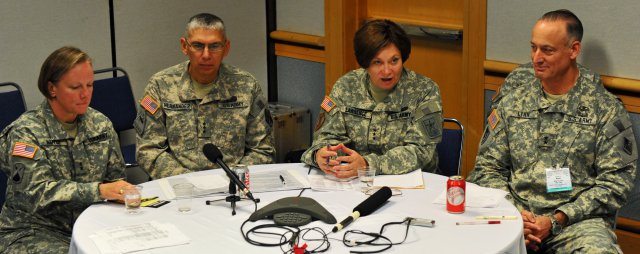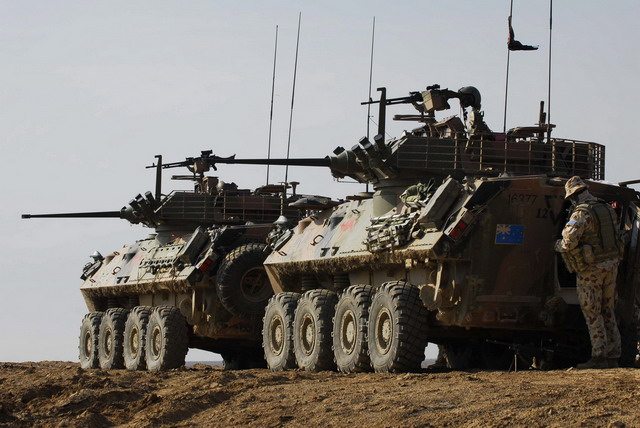The top generals tasked with bringing the most innovative and current technology into the Army’s communications network held a press and bloggers session at the annual LandWarNet conference here Aug. 24, to discuss the network strategic vision moving toward 2020.
Lt. Gen. Rhett A. Hernandez, commander of Army Cyber Command, which just stood up in December 2010, first briefed that his global organization of more than 21,000 Soldiers and civilians was already heavily engaged in operational planning.
The general said the command has already executed realistic cyber integration into major exercises and is currently growing a cyber brigade to serve as the operational arm for full-spectrum capability to fighting commanders.
Hernandez said the three major lines of effort in Cyber Command’s work include operationalizing cyber, growing Army cyber capacity and capability, and recruiting, developing and retaining the right “cyber warrior force.”
Army Chief Information Officer/G-6 Lt. Gen. Susan S. Lawrence said 80 percent of the Army is now based in the continental U.S., or CONUS, and that means an increased focus on stateside-network infrastructure.
“We must have the network empower that CONUS-based Army so they can be better trained and train as they fight,” she said adding that the key is having a “single, secure, standard-based network” that is trusted by Soldiers.
“The problem we have today: 15,000 different networks out there. You can’t share information across those environments — it has to be a single environment,” she said.
Lawrence said the Army would be testing two regional suitcase-sized satellite terminals later in the year — one at Camp Roberts, Calif., and the other on Guam in the western Pacific.
Lawrence said the process of looking to 2020 includes cleaning up applications, determining which applications are relevant, and pinpointing the services and data most needed by Soldiers.
“Access at the point of need, whether in a training environment or operational environment, touching the network is what we’re seeking to do,” she said.
Maj. Gen. Jennifer Napper said her organization, Network Enterprise Technology Command/9th Signal Command, was in the middle of implementing all the global network enterprise initiatives such as enterprise email and data consolidation. She said NetCom was also focusing on transforming the way the Army delivers its capabilities globally.
“We’ve put together a process we’re calling Army Baseline IT (information technology) Services by which we can identify what kind of capabilities and resources are needed in a post, camp or station,” she said.
Napper said she was also focused on how to recruit young talent to help move toward 2020, recognizing that she expects an average of 34 percent of her force to be retirement eligible in the next five years.
Maj. Gen. Alan R. Lynn, commander of the Army Signal Center of Excellence, addressed a future vision for the Signal Corps and its role in the network. He said signal doctrine until recently was of the Desert Storm era, where support was just down to the battalion level.
He said that’s changed and support the center needs to provide — including communications — is now down to the company level and below. The caveat is that the Signal Corps will not grow, but will instead have smaller, more capable teams — much like those the special operations forces use.
“That means smaller, more capable systems off-the-shelf as well, so we’re looking at small handhelds, including iPhones and Droids that will allow us to cover more area with smaller teams,” he said.
“The other thing we’re looking at is the way we train the force, because as these systems come in they’re going to be multiple different kinds of systems a Soldier will have to operate,” Lynn said. He said the plan is teach the theory of satellite, line-of-sight and troposphere scatter, so Soldiers will understand the theory of the systems. Applications are also being developed by the center that will help Soldiers learn how to operate the systems.
“If you give them a proctor and show them a Power Point slide, they’ll just look at you like ‘are you kidding me?”‘ he said.
Lynn said Soldiers like to learn by doing — and teaching systems can be designed to let Soldiers learn virtually — allowing them to have the touch and feel of a particular system on a screen.
“Soldiers are interested in gaming, so several of the centers are working at virtualizing some of the training,” Lynn said, adding that Soldiers really care about their avatar.
“If they go out and shoot marksman at the range, that score is put into the gaming systems, so that’s what their avatar will shoot and when they’re out playing on the virtual gaming environment, they don’t do as their buddies, so their buddies are yelling at their avatar,” he said.
Lynn said the same thing with physical training tests — the avatar only reflects the performance reality and their buddies encourage them to get their scores up, to be a better teammate.
“It’s a new paradigm; a new way of thinking, a new way of training and it’s pretty exciting,” he said.











